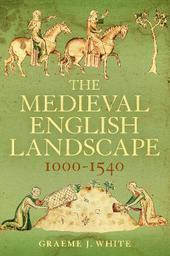
|
The Medieval English Landscape, 1000-1540
Hardback
Main Details
| Title |
The Medieval English Landscape, 1000-1540
|
| Authors and Contributors |
By (author) Dr Graeme J. White
|
| Physical Properties |
| Format:Hardback | | Pages:296 | | Dimensions(mm): Height 234,Width 156 |
|
| ISBN/Barcode |
9781441135063
|
| Classifications | Dewey:942.03 942.03 |
|---|
| Audience | | Undergraduate | | Postgraduate, Research & Scholarly | |
|---|
| Illustrations |
40
|
|
Publishing Details |
| Publisher |
Bloomsbury Publishing Plc
|
| Imprint |
Bloomsbury Academic USA
|
| Publication Date |
6 September 2012 |
| Publication Country |
United States
|
Description
The landscape of medieval England was the product of a multitude of hands. While the power to shape the landscape inevitably lay with the Crown, the nobility and the religious houses, this study also highlights the contribution of the peasantry in the layout of rural settlements and ridge-and-furrow field works, and the funding of parish churches by ordinary townsfolk. The importance of population trends is emphasised as a major factor in shaping the medieval landscape: the rising curve of the eleventh to thirteenth centuries imposing growing pressures on resources, and the devastating impact of the Black Death leading to radical decline in the fourteenth century. Opening with a broad-ranging analysis of political and economic trends in medieval England, the book progresses thematically to assess the impact of farming, rural settlement, towns, the Church, and fortification using many original case studies. The concluding chapter charts the end of the medieval landscape with the dissolution of the monasteries, the replacement of castles by country houses, the ongoing enclosure of fields, and the growth of towns.
Author Biography
Graeme J. White is Emeritus Professor of Local History at the University of Chester, UK. His research interests include the reigns of King Stephen and King Henry II, and rural settlement and field systems. His publications include Restoration and Reform 1153-1165. He is also Editor of the journal, Cheshire History, and President of the Chester Society for Landscape History.
ReviewsThrough skilful use of historical documents and context, Graeme White brings together the people and monuments of medieval England. Through this 500 year period of dramatic social, religious, political and military change, the narrative allows the reader to understand impact of new philosophies and pragmatic responses to circumstance on the physical fabric of the landscape of the day. This book is essential reading for historians and archaeologists alike. -- Stewart Ainsworth, Senior Investigator, English Heritage This book, which will appeal to both students and scholars alike, fills a gap in the subject dealing as it does with the full range of structures to be found in the medieval countryside. It reveals the complexity and diversity of England's farming landscapes, urban settlements and religious and defensive buildings. It provides an up-to-date and lively discussion of the development of the medieval landscape from the pre-Conquest period to the Reformation and will swiftly become a standard text for those interested in the subject. -- Dr Robert Liddiard, Senior Lecturer, School of History, University of East Anglia, UK Writing in a clear and engaging style that assumes no prior knowledge and yet never over simplifies, Graeme stalks the evidence that explains the character of the landscapes of farming, hunting, rural settlement, towns and trade, religion and fortification, Above all he asks over and again who was responsible for what we now see? He does not assume, as many landscape historians seem to have done, that the landscape just evolves: somebody, somewhere took decisions. * The Society of Antiquaries of London Online Newsletter * This book is a clearly written and highly accessible survey of the English medieval landscape which covers a range of topics including farming practices, settlement patterns, the development of towns and the role of religion ... Throughout the book economic history is a useful reference point, and this is a factor in the use of the landscape and a measure of the success of farming and other activities. This book is accessibly and engagingly written, thoroughly referenced with an extensive bibliography, and forms an excellent gateway into the subject. -- Elizabeth Stewart, National Museums Liverpool, UK * Transactions of the Historic Society of Lancashire and Cheshire Vol. 163 *
|